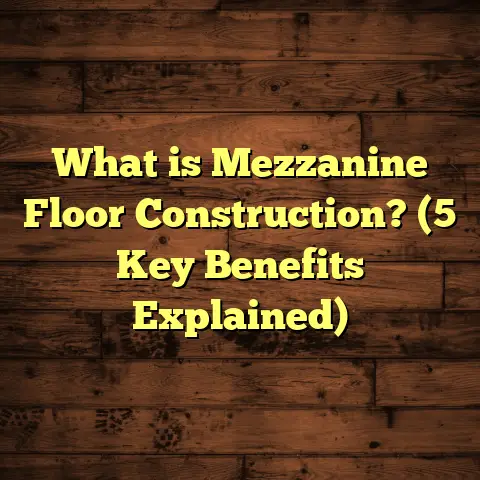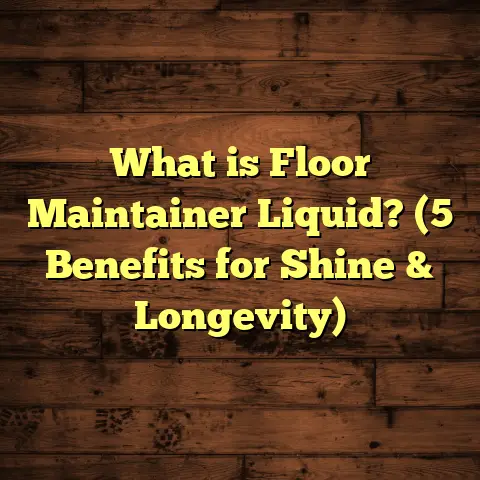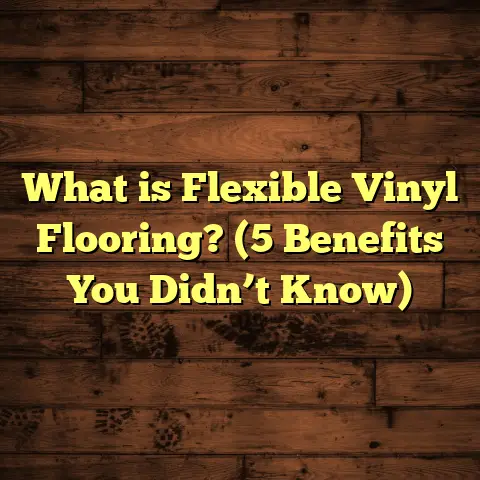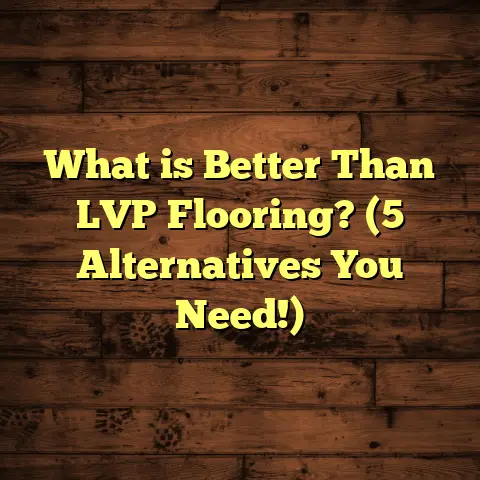What is Resilient Sheet Flooring? (5 Benefits for Your Home)
Have you ever stood in your kitchen or bathroom and thought, “I wish this floor were easier to live with”? Maybe it’s too cold to walk on barefoot, or spills always seem to ruin it, or it just looks outdated and tired. Choosing flooring for a home can be a real puzzle. You want something that lasts, looks good, feels comfortable, and doesn’t drain your wallet. Over the years of working hands-on with various flooring types, I’ve come across many options that promise all these things but fall short somewhere. One material that’s consistently surprised me in terms of versatility and performance is resilient sheet flooring. It’s often overlooked or misunderstood, but it has a lot going for it.
If you’re curious about what exactly resilient sheet flooring is, how it performs in real homes, and whether it might be the answer to your flooring headaches, stick around. I’ll share my personal stories, some solid numbers, and a few lessons learned along the way.
What is Resilient Sheet Flooring?
The phrase “resilient sheet flooring” sounds technical, but it’s pretty straightforward when you break it down. This type of flooring comes as large, flexible sheets made from synthetic or natural materials designed to have a bit of bounce or give when you walk on them. That’s what “resilient” means here—it’s not rigid like tile or hardwood but has some flexibility and cushiness.
These sheets are usually installed over a prepared subfloor as one continuous piece or with minimal seams. That means fewer cracks or joints where dirt and water can sneak in, which makes it ideal for moisture-prone areas like kitchens and bathrooms.
Materials Used in Resilient Sheet Flooring
There are three main types of resilient sheet flooring:
- Vinyl Sheet Flooring: This is the most common and widely used. Made from synthetic materials like PVC (polyvinyl chloride), vinyl sheets are durable, waterproof, and available in a huge range of patterns—from solid colors to wood and stone looks. Vinyl is budget-friendly, making it a popular choice for both residential and commercial spaces.
- Linoleum: Different from vinyl because it’s made from natural ingredients like linseed oil, cork dust, wood flour, and natural pigments. Linoleum has been around since the 19th century and has eco-friendly credentials. It’s durable and ages well but can be pricier than vinyl.
- Rubber Sheet Flooring: Made from natural or synthetic rubber, this type is less common in homes but great for areas needing extra sound absorption or slip resistance. Think gyms, playrooms, or even some kitchens.
How Is It Installed?
Installation usually involves rolling out the sheet over a clean, level subfloor and securing it with adhesive or sometimes with loose lay methods where the weight of the sheet keeps it in place. The seams between sheets are welded or sealed to prevent water infiltration. Because the material is flexible, it can go around curves and corners more easily than rigid tiles or planks.
From what I’ve seen and done myself, proper installation makes all the difference between a floor that lasts 15+ years and one that starts peeling or bubbling in just a few months.
How I First Discovered Resilient Sheet Flooring
Years ago, I was helping a young family renovate their kitchen. They had three toddlers running around with zero tolerance for delicate floors. Their budget was tight, so hardwood was out of the question. Tile seemed cold and unforgiving. We needed something durable but comfortable and easy to clean.
After some research and supplier visits, I suggested resilient sheet flooring—specifically a luxury vinyl sheet with a wood grain design that looked surprisingly real. The family was hesitant at first; they worried about “cheap vinyl” vibes. But after walking on samples and seeing other installations I’d done for friends, they agreed.
The install went smoothly. Two days later, their kitchen looked fresh with warm tones and a smooth finish. The kids could run barefoot without slipping or hurting their feet. Clean-up after spills was effortless. That project stuck with me because it showed how resilient sheet flooring could solve multiple problems at once.
The Successes I’ve Seen With Resilient Sheet Flooring
The more projects I did involving resilient sheets, the more convinced I became that this flooring deserves more attention. Here are some wins I’ve witnessed firsthand:
Longevity and Toughness
One daycare center I worked with had resilient sheet flooring installed about 5 years before I was called in for maintenance. Despite hundreds of energetic kids running around daily, the floor showed only minimal wear—mostly some scuff marks easily cleaned off. The surface was still intact with no peeling seams.
This durability matches industry data: many vinyl sheets come with wear layers (the top protective surface) ranging from 12 mils to 28 mils thickness—the higher the number, the more resistant the floor is to scratches and stains. For heavy residential use, 20 mils is often recommended.
Easy Cleaning and Maintenance
I once helped an elderly client who struggled with bending and scrubbing floors. We installed linoleum resilient sheet flooring because it required no waxing or special treatments—just regular sweeping and mopping with mild cleaners. The client found this life-changing because it meant less strain and more time enjoying her home.
Studies show that homeowners spend on average 1-2 hours per week cleaning floors. Switching to resilient flooring can cut that time down thanks to its smooth surface that doesn’t trap dirt or stains easily.
Comfort That Makes a Difference
Standing on tile or hardwood can tire your legs quickly if you cook often or spend time on your feet. Resilient sheet flooring’s slight cushioning effect helps reduce fatigue. In one kitchen update I did for an avid home cook, they told me their feet hurt less after long meal prep sessions on the new resilient floor.
Rubber variants enhance this even more; they absorb sound and impact better than vinyl or linoleum—ideal for noisy households or multi-level homes where sound travels easily.
Water Resistance for Peace of Mind
Water damage is one of the biggest enemies of floors. Resilient sheet flooring shines here because it forms a nearly seamless surface that blocks water penetration better than tile grout lines or hardwood gaps.
In several basement renovations prone to moisture issues, using vinyl or rubber sheet flooring helped prevent mold growth and warping seen in previous floors. The waterproof nature makes it safe for high-moisture rooms like bathrooms and laundry rooms too.
Affordability That Adds Value
Budget-wise, resilient sheet flooring is one of the best bargains available. Material costs typically fall between $2 to $5 per square foot depending on quality and design complexity; installation adds roughly $1 to $3 per square foot.
Compare that with hardwood starting at $8-$12 per square foot (materials only) or tile which can range widely but often costs more upfront plus grout maintenance later. When factoring in maintenance savings over several years, resilient floors often come out ahead financially.
Challenges I’ve Run Into With Resilient Sheet Flooring
Of course, no product is perfect, and resilient sheet flooring has some limitations I’ve encountered:
Skill-Intensive Installation
While it might look straightforward to roll out a sheet floor yourself, professional installation is key for durability and appearance. If seams aren’t welded properly or adhesives not applied well, you risk bubbling, peeling edges, or uneven surfaces.
I’ve seen clients try DIY and end up frustrated when corners lifted within months or water seeped under damaged seams. Hiring experienced installers pays off big time here.
Style Perceptions Can Be Tough
Some folks still think of resilient sheet flooring as cheap “vinyl” from decades ago—a bland surface that lacks character compared to wood or stone floors. While true low-end options do exist, modern printing technology allows premium sheets to mimic textures like oak grain or marble surprisingly well.
Helping clients choose patterns that match their decor helps combat this stigma. Sometimes adding area rugs also softens the look.
Subfloor Preparation Matters More Than You’d Think
Because resilient sheets are thin (typically 2mm to 5mm), any bumps or unevenness underneath can telegraph through the surface leading to unsightly imperfections.
I always tell homeowners: spend time getting your subfloor right—cleaned, leveled, patched—before installation begins. It adds time upfront but saves headaches later.
Environmental Concerns
Vinyl is made from PVC plastics which aren’t biodegradable; while newer products have improved emissions standards (low VOCs), environmental impact remains a concern for eco-aware buyers.
Linoleum offers a greener alternative but may cost more initially and require periodic sealing to protect against moisture damage.
Repair Is Not Always Simple
Unlike tile where you can replace one piece easily or hardwood where boards can be swapped out individually, damaged resilient sheets usually require patching with matching material that can be tricky to source perfectly—especially if discontinued models are involved.
Often replacing entire sections is necessary for best results.
What Data Shows About Resilient Sheet Flooring Performance
Here’s some useful data from industry research combined with what I’ve seen on projects:
| Feature | Data/Statistic | Source/Notes |
|---|---|---|
| Typical Lifespan | 10-20 years with proper care | RFCI (Resilient Floor Covering Institute) |
| Wear Layer Thickness | 12 – 28 mils (higher = better durability) | Manufacturer specs |
| Cost per Square Foot | $2 – $5 material; $1 – $3 installation | HomeAdvisor estimates |
| Water Resistance | High due to seamless installation | Industry reports |
| Maintenance Requirements | Weekly sweeping + monthly mopping typically enough | Manufacturer guidelines |
| VOC Emissions | Low-VOC products available to improve indoor air quality | GreenGuard Certified products |
| Repair Complexity | Moderate; patching possible but color matching tough | Field reports |
Personal Insights That Might Help You Decide
If you’re thinking about resilient sheet flooring for your home project,
- Don’t skimp on subfloor prep.
- Choose a thicker wear layer if you expect pets or heavy foot traffic.
- Consider professional installation unless you’re very handy.
- Look at samples in your home lighting before committing.
- Factor in long-term maintenance savings versus upfront cost.
- Explore linoleum if environmental impact matters to you.
- Use area rugs strategically to elevate style where needed.
- Ask your installer about warranty coverage specific to wear layers and adhesion.
Case Study #1: Family Kitchen Renovation With Luxury Vinyl Sheets
A family of five in Seattle wanted to upgrade their kitchen floor without breaking the bank or sacrificing comfort. Their old tile was cold and slippery when wet—tough with two toddlers running around.
We selected a luxury vinyl sheet floor mimicking warm oak wood with a 20-mil wear layer for durability. After prepping the subfloor carefully (which took nearly half the project time), installers glued down the sheets seamlessly.
The family reported back after six months that spills wiped up easily and their kids loved running barefoot without slipping as before. The floor felt warm and soft underfoot but held up well even when heavy pots fell accidentally.
Case Study #2: Basement Gym With Rubber Sheet Flooring
A homeowner in Chicago wanted a home gym space that was safe from noise complaints by neighbors downstairs and easy on his knees during workouts.
We installed 4mm thick rubber resilient sheets over a concrete slab with minimal seams welded tight to prevent moisture intrusion. The surface reduced impact noise noticeably compared to bare concrete or plywood subfloors previously used.
He appreciated how easy it was to mop sweat away after sessions plus how cushioned his joints felt during exercises like jumping rope.
I hope these experiences and insights give you a clearer picture of what resilient sheet flooring is all about and why it might be just what you need for your next home project. It offers durability, comfort, water resistance, ease of care, and affordability—all solid reasons enough for me to recommend it often.
Thinking about making a switch? Take your time exploring options but don’t overlook this versatile solution that continues to surprise me every time I work with it.
If you want help figuring out costs or comparing materials specific to your space, feel free to ask—I’m here to help break down those numbers so you get the best fit for your needs!
(End of article)





